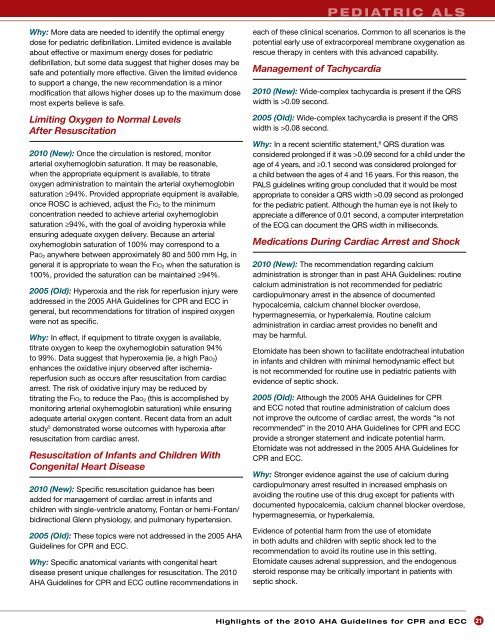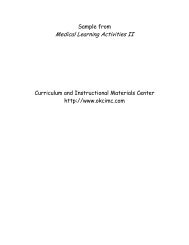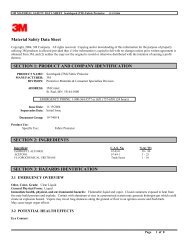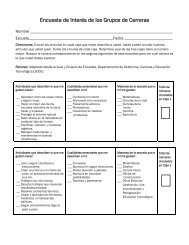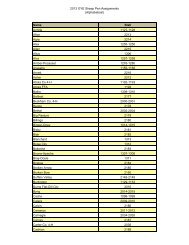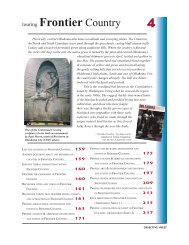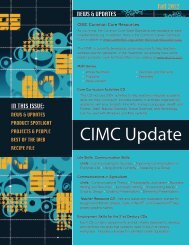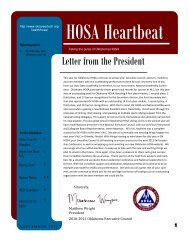Highlights of the 2010 Guidelines for CPR and ECC - ECC Guidelines
Highlights of the 2010 Guidelines for CPR and ECC - ECC Guidelines
Highlights of the 2010 Guidelines for CPR and ECC - ECC Guidelines
You also want an ePaper? Increase the reach of your titles
YUMPU automatically turns print PDFs into web optimized ePapers that Google loves.
p e d i a t r i c A L S<br />
Why: More data are needed to identify <strong>the</strong> optimal energy<br />
dose <strong>for</strong> pediatric defibrillation. Limited evidence is available<br />
about effective or maximum energy doses <strong>for</strong> pediatric<br />
defibrillation, but some data suggest that higher doses may be<br />
safe <strong>and</strong> potentially more effective. Given <strong>the</strong> limited evidence<br />
to support a change, <strong>the</strong> new recommendation is a minor<br />
modification that allows higher doses up to <strong>the</strong> maximum dose<br />
most experts believe is safe.<br />
Limiting Oxygen to Normal Levels<br />
After Resuscitation<br />
<strong>2010</strong> (New): Once <strong>the</strong> circulation is restored, monitor<br />
arterial oxyhemoglobin saturation. It may be reasonable,<br />
when <strong>the</strong> appropriate equipment is available, to titrate<br />
oxygen administration to maintain <strong>the</strong> arterial oxyhemoglobin<br />
saturation ≥94%. Provided appropriate equipment is available,<br />
once ROSC is achieved, adjust <strong>the</strong> Fio 2 to <strong>the</strong> minimum<br />
concentration needed to achieve arterial oxyhemoglobin<br />
saturation ≥94%, with <strong>the</strong> goal <strong>of</strong> avoiding hyperoxia while<br />
ensuring adequate oxygen delivery. Because an arterial<br />
oxyhemoglobin saturation <strong>of</strong> 100% may correspond to a<br />
Pao 2 anywhere between approximately 80 <strong>and</strong> 500 mm Hg, in<br />
general it is appropriate to wean <strong>the</strong> Fio 2 when <strong>the</strong> saturation is<br />
100%, provided <strong>the</strong> saturation can be maintained ≥94%.<br />
2005 (Old): Hyperoxia <strong>and</strong> <strong>the</strong> risk <strong>for</strong> reperfusion injury were<br />
addressed in <strong>the</strong> 2005 AHA <strong>Guidelines</strong> <strong>for</strong> <strong>CPR</strong> <strong>and</strong> <strong>ECC</strong> in<br />
general, but recommendations <strong>for</strong> titration <strong>of</strong> inspired oxygen<br />
were not as specific.<br />
Why: In effect, if equipment to titrate oxygen is available,<br />
titrate oxygen to keep <strong>the</strong> oxyhemoglobin saturation 94%<br />
to 99%. Data suggest that hyperoxemia (ie, a high Pao 2 )<br />
enhances <strong>the</strong> oxidative injury observed after ischemiareperfusion<br />
such as occurs after resuscitation from cardiac<br />
arrest. The risk <strong>of</strong> oxidative injury may be reduced by<br />
titrating <strong>the</strong> Fio 2 to reduce <strong>the</strong> Pao 2 (this is accomplished by<br />
monitoring arterial oxyhemoglobin saturation) while ensuring<br />
adequate arterial oxygen content. Recent data from an adult<br />
study 5 demonstrated worse outcomes with hyperoxia after<br />
resuscitation from cardiac arrest.<br />
Resuscitation <strong>of</strong> Infants <strong>and</strong> Children With<br />
Congenital Heart Disease<br />
<strong>2010</strong> (New): Specific resuscitation guidance has been<br />
added <strong>for</strong> management <strong>of</strong> cardiac arrest in infants <strong>and</strong><br />
children with single-ventricle anatomy, Fontan or hemi-Fontan/<br />
bidirectional Glenn physiology, <strong>and</strong> pulmonary hypertension.<br />
2005 (Old): These topics were not addressed in <strong>the</strong> 2005 AHA<br />
<strong>Guidelines</strong> <strong>for</strong> <strong>CPR</strong> <strong>and</strong> <strong>ECC</strong>.<br />
Why: Specific anatomical variants with congenital heart<br />
disease present unique challenges <strong>for</strong> resuscitation. The <strong>2010</strong><br />
AHA <strong>Guidelines</strong> <strong>for</strong> <strong>CPR</strong> <strong>and</strong> <strong>ECC</strong> outline recommendations in<br />
each <strong>of</strong> <strong>the</strong>se clinical scenarios. Common to all scenarios is <strong>the</strong><br />
potential early use <strong>of</strong> extracorporeal membrane oxygenation as<br />
rescue <strong>the</strong>rapy in centers with this advanced capability.<br />
Management <strong>of</strong> Tachycardia<br />
<strong>2010</strong> (New): Wide-complex tachycardia is present if <strong>the</strong> QRS<br />
width is >0.09 second.<br />
2005 (Old): Wide-complex tachycardia is present if <strong>the</strong> QRS<br />
width is >0.08 second.<br />
Why: In a recent scientific statement, 6 QRS duration was<br />
considered prolonged if it was >0.09 second <strong>for</strong> a child under <strong>the</strong><br />
age <strong>of</strong> 4 years, <strong>and</strong> ≥0.1 second was considered prolonged <strong>for</strong><br />
a child between <strong>the</strong> ages <strong>of</strong> 4 <strong>and</strong> 16 years. For this reason, <strong>the</strong><br />
PALS guidelines writing group concluded that it would be most<br />
appropriate to consider a QRS width >0.09 second as prolonged<br />
<strong>for</strong> <strong>the</strong> pediatric patient. Although <strong>the</strong> human eye is not likely to<br />
appreciate a difference <strong>of</strong> 0.01 second, a computer interpretation<br />
<strong>of</strong> <strong>the</strong> ECG can document <strong>the</strong> QRS width in milliseconds.<br />
Medications During Cardiac Arrest <strong>and</strong> Shock<br />
<strong>2010</strong> (New): The recommendation regarding calcium<br />
administration is stronger than in past AHA <strong>Guidelines</strong>: routine<br />
calcium administration is not recommended <strong>for</strong> pediatric<br />
cardiopulmonary arrest in <strong>the</strong> absence <strong>of</strong> documented<br />
hypocalcemia, calcium channel blocker overdose,<br />
hypermagnesemia, or hyperkalemia. Routine calcium<br />
administration in cardiac arrest provides no benefit <strong>and</strong><br />
may be harmful.<br />
Etomidate has been shown to facilitate endotracheal intubation<br />
in infants <strong>and</strong> children with minimal hemodynamic effect but<br />
is not recommended <strong>for</strong> routine use in pediatric patients with<br />
evidence <strong>of</strong> septic shock.<br />
2005 (Old): Although <strong>the</strong> 2005 AHA <strong>Guidelines</strong> <strong>for</strong> <strong>CPR</strong><br />
<strong>and</strong> <strong>ECC</strong> noted that routine administration <strong>of</strong> calcium does<br />
not improve <strong>the</strong> outcome <strong>of</strong> cardiac arrest, <strong>the</strong> words “is not<br />
recommended” in <strong>the</strong> <strong>2010</strong> AHA <strong>Guidelines</strong> <strong>for</strong> <strong>CPR</strong> <strong>and</strong> <strong>ECC</strong><br />
provide a stronger statement <strong>and</strong> indicate potential harm.<br />
Etomidate was not addressed in <strong>the</strong> 2005 AHA <strong>Guidelines</strong> <strong>for</strong><br />
<strong>CPR</strong> <strong>and</strong> <strong>ECC</strong>.<br />
Why: Stronger evidence against <strong>the</strong> use <strong>of</strong> calcium during<br />
cardiopulmonary arrest resulted in increased emphasis on<br />
avoiding <strong>the</strong> routine use <strong>of</strong> this drug except <strong>for</strong> patients with<br />
documented hypocalcemia, calcium channel blocker overdose,<br />
hypermagnesemia, or hyperkalemia.<br />
Evidence <strong>of</strong> potential harm from <strong>the</strong> use <strong>of</strong> etomidate<br />
in both adults <strong>and</strong> children with septic shock led to <strong>the</strong><br />
recommendation to avoid its routine use in this setting.<br />
Etomidate causes adrenal suppression, <strong>and</strong> <strong>the</strong> endogenous<br />
steroid response may be critically important in patients with<br />
septic shock.<br />
<strong>Highlights</strong> <strong>of</strong> <strong>the</strong> <strong>2010</strong> AHA <strong>Guidelines</strong> <strong>for</strong> <strong>CPR</strong> <strong>and</strong> <strong>ECC</strong> 21


